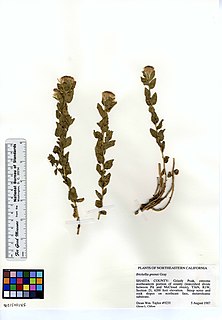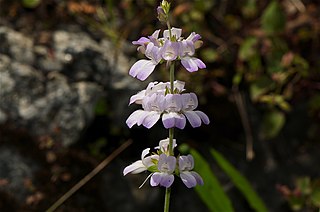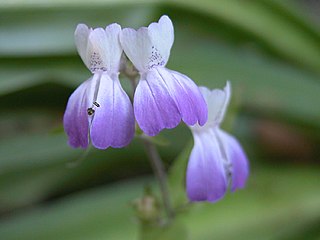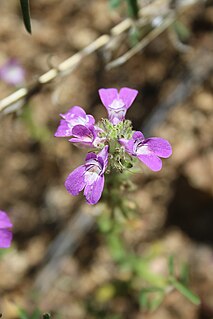
Collinsia parryi is a species of flowering plant in the plantain family known by the common name Parry's blue eyed Mary. It is endemic to central and southern California, where it is found in the southern Coast Ranges and in the Transverse Ranges north and east of Los Angeles.

Brickellia greenei is a species of flowering plant in the family Asteraceae known by the common name Greene's brickellbush. It is native to the mountain ranges of southwestern Oregon and northern California, including the Cascades, the northern Coast Ranges, and Sierra Nevada.

Collinsia bartsiifolia is a species of flowering plant in the plantain family known by the common name white blue-eyed Mary.

Collinsia callosa is a species of flowering plant in the plantain family known by the common name desert mountain blue-eyed Mary. It is endemic to California, where it grows in the mountains of the southernmost Sierra Nevada, the Transverse Ranges, and the mountains of the Mojave Desert region. It grows in desert scrub, chaparral, and woodland habitat on the mountain slopes.

Collinsia childii is a species of flowering plant in the plantain family known by the common name Child's blue-eyed Mary.

Collinsia concolor is a species of flowering plant in the plantain family known by the common name Chinese houses.
Collinsia corymbosa is a species of flowering plant in the plantain family known by the common name round-headed Chinese houses. It is endemic to the coastline of California north of the San Francisco Bay Area, where it is uncommon and scattered. Its habitat is the sand dunes of the immediate coastline. This is an annual herb producing a scaly, hairy, red to reddish green stem which grows upright or decumbent to a maximum length of about 25 centimeters. The thick, sparsely hairy leaves are rippled and lobed along the edges, which may be somewhat turned under. The inflorescence is a dense whorl of several distinctive flowers. Each has a hairy calyx of lobed reddish sepals and a corolla up to about 2 centimeters long. The flower has two small upper lobes and three longer lower lobes which come together in a nearly tubular shape. It is generally white with a light purple tint. The smaller upper lobes curl back and dry to brown at their lips.
Collinsia linearis is a species of flowering plant in the plantain family known by the common name narrowleaf blue-eyed Mary.

Collinsia multicolor is a species of flowering plant in the plantain family, known by the common names San Francisco blue eyed Mary and San Francisco collinsia. It is endemic to the San Francisco Bay Area, where it is known from San Francisco to Santa Cruz. As of 2008 there are 22 known occurrences. Populations south of Santa Cruz have been extirpated.
Collinsia rattanii is a species of flowering plant in the plantain family known by the common name sticky blue-eyed Mary. It is native to the coniferous forests of the Pacific Northwest of the United States from Washington to northern California. It is an annual herb growing up to 40 centimeters tall with linear leaves rolled under along the edges. The leaves are hairy on the upper surface and hairless and purple-tinted underneath. The inflorescence is coated in sticky glandular hairs. It has a series of nodes from which arise one to five flowers each on pedicels. The flower is only 4 to 8 millimeters long, with two mostly white upper lobes and three mostly purple lower lobes.

Collinsia tinctoria is a species of flowering plant in the family Plantaginaceae known by the common names sticky Chinese houses and tincture plant.

Collinsia torreyi is a species of flowering plant in the plantain family known by the common name Torrey's blue-eyed Mary. It is native to California and adjacent sections of Oregon and Nevada, where it grows in the coniferous forests of several mountain ranges, including the Sierra Nevada.

Ericameria greenei is a species of flowering shrub in the daisy family known by the common name Greene's goldenbush. It is native to the mountains of the western United States in Washington, Idaho, Oregon, and the northern California as far south as Lake and Tuolumne Counties.
Lessingia virgata is a species of flowering plant in the family Asteraceae known by the common name wand lessingia. It is endemic to California, where it is known from the eastern side of the Central Valley and adjacent Sierra Nevada foothills. It is a woolly, glandular annual herb growing up to about 60 centimeters tall with slender, spreading branches. The upper leaves are no more than a centimeter long, while the lower ones are longer and sometimes divided into lobes or teeth. The flower heads appear singly in leaf axils, each lined with purple-tipped, glandular, woolly phyllaries. The head is discoid, containing no ray florets but a few tubular light lavender to nearly white disc florets with long, narrow lobes. The fruit is an achene with a whitish pappus on top.

Orthocarpus cuspidatus is a species of flowering plant in the broomrape family known by the common names Copeland's owl's clover, Siskiyou Mountains orthocarpus, and toothed owl's-clover. It is native to mountain and plateau habitat in Oregon, California, and Nevada. It is an annual herb producing a slender, glandular, hairy, purple-green stem up to about 40 centimeters tall. The narrow leaves are up to 5 centimeters long, the upper ones deeply divided into three linear lobes. The inflorescence is a dense cylindrical spike of wide, oval green bracts with pinkish points. The flowers emerge from between the bracts. Each purple-pink flower is fuzzy in texture and club-shaped, the lower lip an expanded pouch and the upper lip a narrow, straight beak.

Phacelia greenei is a species of phacelia known by the common name Scott Valley phacelia. It is endemic to the southern Klamath Mountains of far northern California, where it is known only from Scott Valley, a valley known for its alfalfa growing, and vicinity.

Ribes sericeum is a species of currant known by the common name Lucia gooseberry, or Santa Lucia gooseberry; its Latin epithet of sericeum means "of silk". It is endemic to California, where it is known only from the Santa Lucia Mountains along the Central Coast and an additional isolated population in Santa Barbara County.

Silene bernardina is a species of flowering plant in the family Caryophyllaceae known by the common name Palmer's catchfly.

Silene campanulata is a species of flowering plant in the family Caryophyllaceae known by the common names Red Mountain catchfly and bell catchfly. It may be a synonym of Silene greenei.

Veronica cusickii is a species of flowering plant in the plantain family known by the common name Cusick's speedwell. It is native to western North America from British Columbia to Montana to northern California, where it occurs in mountain meadows and forests.















